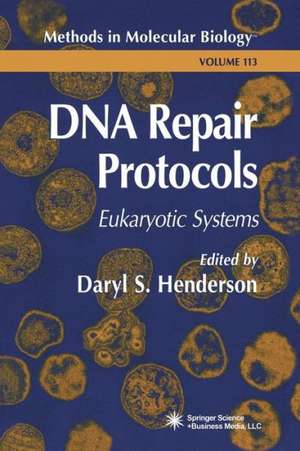DNA Repair Protocols: Eukaryotic Systems: Methods in Molecular Biology, cartea 113
Editat de Daryl S. Hendersonen Limba Engleză Paperback – 23 mar 2013
| Toate formatele și edițiile | Preț | Express |
|---|---|---|
| Paperback (4) | 950.80 lei 43-57 zile | |
| Humana Press Inc. – 19 noi 2010 | 950.80 lei 43-57 zile | |
| Humana Press Inc. – 10 noi 2010 | 958.21 lei 43-57 zile | |
| Humana Press Inc. – 21 iun 1999 | 959.98 lei 43-57 zile | |
| Humana Press Inc. – 23 mar 2013 | 960.61 lei 43-57 zile | |
| Hardback (2) | 965.02 lei 43-57 zile | |
| Humana Press Inc. – oct 2005 | 965.02 lei 43-57 zile | |
| Humana Press Inc. – 21 iun 1999 | 969.93 lei 43-57 zile |
Din seria Methods in Molecular Biology
- 9%
 Preț: 791.59 lei
Preț: 791.59 lei - 23%
 Preț: 598.56 lei
Preț: 598.56 lei - 20%
 Preț: 882.95 lei
Preț: 882.95 lei -
 Preț: 252.04 lei
Preț: 252.04 lei - 5%
 Preț: 802.69 lei
Preț: 802.69 lei - 5%
 Preț: 729.61 lei
Preț: 729.61 lei - 5%
 Preț: 731.43 lei
Preț: 731.43 lei - 5%
 Preț: 741.30 lei
Preț: 741.30 lei - 5%
 Preț: 747.16 lei
Preț: 747.16 lei - 15%
 Preț: 663.45 lei
Preț: 663.45 lei - 18%
 Preț: 1025.34 lei
Preț: 1025.34 lei - 5%
 Preț: 734.57 lei
Preț: 734.57 lei - 18%
 Preț: 914.20 lei
Preț: 914.20 lei - 15%
 Preț: 664.61 lei
Preț: 664.61 lei - 15%
 Preț: 654.12 lei
Preț: 654.12 lei - 18%
 Preț: 1414.74 lei
Preț: 1414.74 lei - 5%
 Preț: 742.60 lei
Preț: 742.60 lei - 20%
 Preț: 821.63 lei
Preț: 821.63 lei - 18%
 Preț: 972.30 lei
Preț: 972.30 lei - 15%
 Preț: 660.49 lei
Preț: 660.49 lei - 5%
 Preț: 738.41 lei
Preț: 738.41 lei - 18%
 Preț: 984.92 lei
Preț: 984.92 lei - 5%
 Preț: 733.29 lei
Preț: 733.29 lei -
 Preț: 392.58 lei
Preț: 392.58 lei - 5%
 Preț: 746.26 lei
Preț: 746.26 lei - 18%
 Preț: 962.66 lei
Preț: 962.66 lei - 23%
 Preț: 860.21 lei
Preț: 860.21 lei - 15%
 Preț: 652.64 lei
Preț: 652.64 lei - 5%
 Preț: 1055.50 lei
Preț: 1055.50 lei - 23%
 Preț: 883.85 lei
Preț: 883.85 lei - 19%
 Preț: 491.88 lei
Preț: 491.88 lei - 5%
 Preț: 1038.84 lei
Preț: 1038.84 lei - 5%
 Preț: 524.15 lei
Preț: 524.15 lei - 18%
 Preț: 2122.34 lei
Preț: 2122.34 lei - 5%
 Preț: 1299.23 lei
Preț: 1299.23 lei - 5%
 Preț: 1339.10 lei
Preț: 1339.10 lei - 18%
 Preț: 1390.26 lei
Preț: 1390.26 lei - 18%
 Preț: 1395.63 lei
Preț: 1395.63 lei - 18%
 Preț: 1129.65 lei
Preț: 1129.65 lei - 18%
 Preț: 1408.26 lei
Preț: 1408.26 lei - 18%
 Preț: 1124.92 lei
Preț: 1124.92 lei - 18%
 Preț: 966.27 lei
Preț: 966.27 lei - 5%
 Preț: 1299.99 lei
Preț: 1299.99 lei - 5%
 Preț: 1108.51 lei
Preț: 1108.51 lei - 5%
 Preț: 983.72 lei
Preț: 983.72 lei - 5%
 Preț: 728.16 lei
Preț: 728.16 lei - 18%
 Preț: 1118.62 lei
Preț: 1118.62 lei - 18%
 Preț: 955.25 lei
Preț: 955.25 lei - 5%
 Preț: 1035.60 lei
Preț: 1035.60 lei - 18%
 Preț: 1400.35 lei
Preț: 1400.35 lei
Preț: 960.61 lei
Preț vechi: 1171.47 lei
-18% Nou
Puncte Express: 1441
Preț estimativ în valută:
183.81€ • 192.43$ • 152.09£
183.81€ • 192.43$ • 152.09£
Carte tipărită la comandă
Livrare economică 07-21 aprilie
Preluare comenzi: 021 569.72.76
Specificații
ISBN-13: 9781468471441
ISBN-10: 1468471449
Pagini: 668
Ilustrații: XXI, 641 p. 72 illus.
Dimensiuni: 152 x 229 x 35 mm
Greutate: 0.88 kg
Ediția:1999
Editura: Humana Press Inc.
Colecția Humana
Seria Methods in Molecular Biology
Locul publicării:Totowa, NJ, United States
ISBN-10: 1468471449
Pagini: 668
Ilustrații: XXI, 641 p. 72 illus.
Dimensiuni: 152 x 229 x 35 mm
Greutate: 0.88 kg
Ediția:1999
Editura: Humana Press Inc.
Colecția Humana
Seria Methods in Molecular Biology
Locul publicării:Totowa, NJ, United States
Public țintă
ResearchCuprins
I. Mutant Isolation and Gene Cloning.- 1 Isolation of DNA Structure-Dependent Checkpoint Mutants in S. pombe.- 2 Isolating Mutants of the Nematode Caenorhabditis elegans That Are Hypersensitive to DNA-Damaging Agents.- 3 Isolating DNA Repair Mutants of Drosophila melanogaster.- 4 Generation, Identification, and Characterization of Repair-Defective Mutants of Arabidopsis.- 5 Screening for ?-Ray Hypersensitive Mutants of Arabidopsis.- 6 Isolation of Mutagen-Sensitive Chinese Hamster Cell Lines by Replica Plating.- 7 Strategies for Cloning Mammalian DNA Repair Genes.- 8 Novel Complementation Assays for DNA Repair-Deficient Cells: Transient and Stable Expression of DNA Repair Genes.- II. Recognition and Removal of Inappropriate or Damaged DNA Bases.- 9 The Use of Electrophoretic Mobility Shift Assays to Study DNA Repair.- 10 Mismatch Repair Assay.- 11 Measurement of Activities of Cyclobutane-Pyrimidine-Dimer and (6-4)-Photoproduct Photolyases.- 12 A Dot Blot Immunoassay for UV Photoproducts.- 13 Measurement of UV Radiation-Induced DNA Damage Using Specific Antibodies.- 14 Quantification of Photoproducts in Mammalian Cell DNA Using Radioimmunoassay.- 15 Monitoring Removal of Cyclobutane Pyrimidine Dimers in Arabidopsis.- 16 DNA Damage Quantitation by Alkaline Gel Electrophoresis.- 17 The Comet Assay (Single-Cell Gel Test): A Sensitive Genotoxicity Test for the Detection of DNA Damage and Repair.- 18 Measuring the Formation and Repair of UV Photoproducts by Ligation-Mediated PCR.- 19 PCR-Based Assays for Strand-Specific Measurement of DNA Damage and Repair I: Strand-Specific Quantitative PCR.- 20 PCR-Based Assays for Strand-Specific Measurement of DNA Damage and Repair II: Single-Strand Ligation-PCR.- 21 Gene-Specific and Mitochondrial Repair of Oxidative DNA Damage.- 22Characterization of DNA Strand Cleavage by Enzymes That Act at Abasic Sites in DNA.- 23 Base Excision Repair Assay Using Xenopus laevis Oocyte Extracts.- 24 In Vitro Base Excision Repair Assay Using Mammalian Cell Extracts.- 25 Nucleotide Excision Repair in Saccharomyces cerevisiae Whole-Cell Extracts.- 26 In Vitro Excision Repair Assay in Schizosaccharomyces pombe.- 27 Nucleotide Excision Repair Assay in Drosophila melanogaster Using Established Cell Lines.- 28 Nucleotide Excision Repair in Nuclear Extracts from Xenopus Oocytes.- 29 Assay for Nucleotide Excision Repair Protein Activity Using Fractionated Cell Extracts and UV-Damaged Plasmid DNA.- 30 Dual-Incision Assays for Nucleotide Excision Repair Using DNA with a Lesion at a Specific Site.- 31 In Vitro Chemiluminescence Assay to Measure Excision Repair in Cell Extracts.- III. DNA Strand Breakage and Repair.- 32 Physical Monitoring of HO-Induced Homologous Recombination.- 33 Use of P Element Transposons to Study DNA Double-Strand Break Repair in Drosophila melanogaster.- 34 Analyzing Double-Strand Repair Events in Drosophila.- 35 Expression of I-Sce I in Drosophila to Induce DNA Double-Strand Breaks.- 36 Use of I-Sce I to Induce DNA Double-Strand Breaks in Nicotiana.- 37 Chromosomal Double-Strand Breaks Introduced in Mammalian Cells by Expression of I-Sce I Endonuclease.- 38 Induction of DNA Double-Strand Breaks by Electroporation of Restriction Enzymes into Mammalian Cells.- 39 In Vitro Rejoining of Double-Strand Breaks in Genomic DNA.- 40 Extrachromosomal Assay for DNA Double-Strand Break Repair.- 41 Use of Gene Targeting to Study Recombination in Mammalian DNA Repair Mutants.- 42 Measurement of Low-Frequency DNA Breaks Using Nucleoid Flow Cytometry.- IV. DNA Damage Tolerance Mechanisms and Regulatory Responses.- 43 Live Analysis of the Division Cycles in X-Irradiated Drosophila Embryos.- 44 Inhibition of DNA Synthesis by Ionizing Radiation.- 45 Analysis of Inhibition of DNA Replication in Irradiated Cells Using the SV40-Based In Vitro Assay of DNA Replication.- 46 Assays of Bypass Replication of Genotoxic Lesions in Mammalian Disease and Mutant Cell-Free Extracts.- 47 Detection of Chromatin-Bound PCNA in Cultured Cells Following Exposure to DNA-Damaging Agents.- 48 Induction of p53 Protein as a Marker for Ionizing Radiation Exposure In Vivo.- 49 Activation of p53 Protein Function in Response to Cellular Irradiation.- 50 Selective Extraction of Fragmented DNA from Apoptotic Cells for Analysis by Gel Electrophoresis and Identification of Apoptotic Cells by Flow Cytometry.- 51 Detection of DNA Strand Breakage in the Analysis of Apoptosis and Cell Proliferation by Flow and Laser Scanning Cytometry.- 52 Immunoassay for Single-Stranded DNA in Apoptotic Cells.
Recenzii
"...It will serve as an essential reference for both the practical and theoretical aspects of DNA repair studies, encourage the transfer of methodologies between model systems, and stimulate the development of new approaches." - Anticancer Research
Textul de pe ultima copertă
In DNA Repair Protocols: Eukaryotic Systems, Daryl S. Henderson and a team of hands-on experts give time-tested instructions for analyzing a wide range of DNA repair processes and cellular responses to DNA damage, including nucleotide and base excision repair, DNA strand break repair, and mismatch repair. The methods focus on eukaryotic model systems that have made, or have the potential to make, important contributions to our understanding of cellular responses to DNA damage in relation to mutagenesis, carcinogenesis, and the cell cycle. Although mammalian cells predominate, consideration is also given to such important nonmammalian model systems as yeast, C. elegans (nematode), Drosophila (fruitfly), Xenopus (amphibian), and plants.
DNA Repair Protocols: Eukaryotic Systems offers the most comprehensive collection of DNA repair protocols available, all step-by-step, optimized, and eminently reproducible with tips on troubleshooting and avoiding pitfalls. It will serve as the gold-standard reference for both the practical and theoretical aspects of DNA repair studies, encourage the transfer of methodologies between model systems, and stimulate the development of new approaches.
DNA Repair Protocols: Eukaryotic Systems offers the most comprehensive collection of DNA repair protocols available, all step-by-step, optimized, and eminently reproducible with tips on troubleshooting and avoiding pitfalls. It will serve as the gold-standard reference for both the practical and theoretical aspects of DNA repair studies, encourage the transfer of methodologies between model systems, and stimulate the development of new approaches.
Caracteristici
Includes supplementary material: sn.pub/extras












